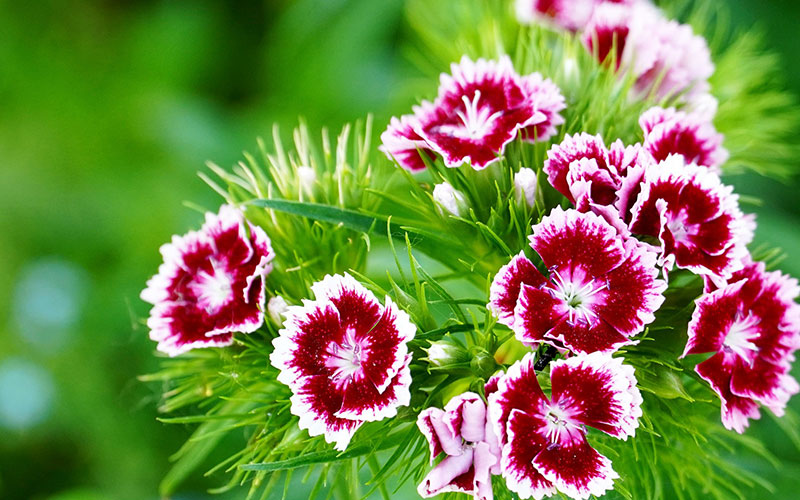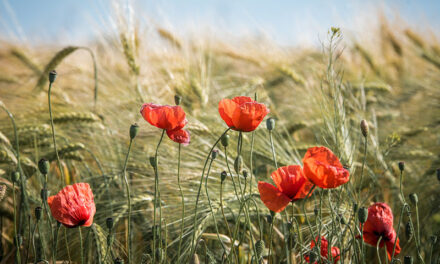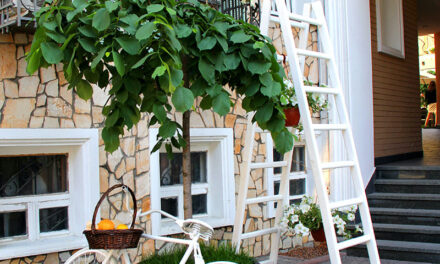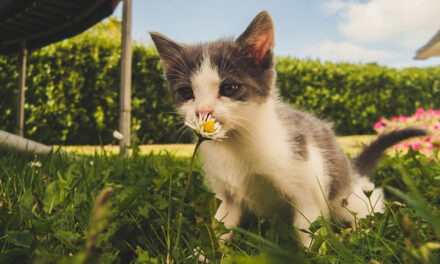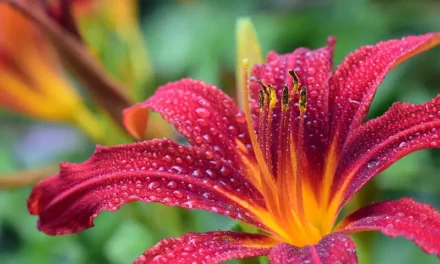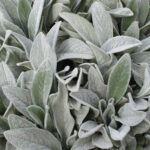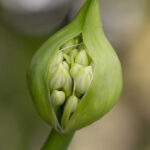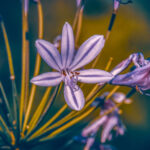There are a remarkable number of carnation types, with estimates ranging from 320 to 600 varieties! The carnation, also known as the clove pink, is a perennial herbaceous plant with slender gray-green or blue-green leaves. While some carnations are annual plants, most are perennial. These striking flowers come in countless vibrant colors. In the wild, they display a beautiful purple-pink hue, but cultivated varieties can be found in red, white, yellow, green, salmon, and even two-toned variations. Carnations bloom from May to June and can be found throughout Europe and Asia.
Most Dianthus varieties function as ground covers, making them perfect for planting along paths and at the front of borders. Clove pinks are hardy perennial plants that remain evergreen. They are particularly well-suited for rock gardens. Alongside ground covers, there are also taller species, such as the Dianthus Barbatus, which can grow up to 70 centimeters in height.
Carnation flower
The carnation flower exhibits various shapes, including single flowers and spray carnations. Its petals are distinct, featuring rounded, serrated, or fringed edges. The fragrance of the clove pink is subtle. The calyx of the carnation is tubular, with five lobes, and is surrounded at its base by two, four, or six broad petals. The flower has ten stamens and two pistils.
Carnation flower meaning
In general, the carnation flower symbolizes desire, passion, and romance. However, its symbolic meaning can vary based on its color. For example, the white carnation is known as the “volunteer flower,” representing resistance and appreciation for veterans. Conversely, the light red carnation stands for admiration, while the dark red carnation symbolizes love and affection. The green carnation is a symbol of Saint Patrick’s Day in Ireland.
Dianthus caryophyllus
The botanical name for the carnation is Dianthus. This name is derived from the Greek words “dios” meaning god, and “anthos” meaning flower. Dianthus belongs to the Caryophyllaceae family, also known as the carnation family, and comprises numerous subspecies. Below, we present a list of the eleven most beautiful types of carnation flowers.
Sweet William
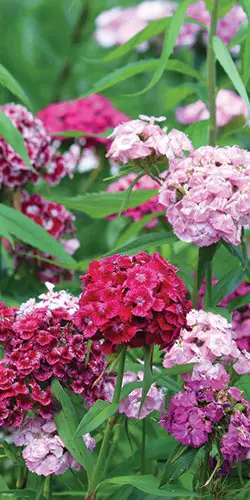
| Common name | Sweet William |
| Scientific name | Dianthus barbatus |
| Type of plant | Perennial |
| Color flower | Mixed |
| Leaf color | Green |
| Flowering time | June/July |
| Location | Sunny |
| Evergreen | Yes |
| Height | 70cm |
Sweet William, also known as Dianthus Barbatus, is an elegant tall carnation. It is a perennial plant that reaches a height of approximately 70cm. The leaves are green and about 30cm in height. Sweet William blooms from June to July.
This lovely plant remains green throughout the winter and thrives in south-facing gardens. It prefers a sunny and warm location with fertile soil, making it a perfect addition to your garden border. Sweet William complements many other plants beautifully.
During winter, it is advisable to protect the Dianthus Barbatus from excessive rain or snow. In the summer, ensure that the plant doesn’t become too dry. Regular watering is essential, especially during dry periods.
Sweet William does not spread aggressively.
Planting Sweet William
The ideal time to sow Dianthus Barbatus is in June or July. Sow the Sweet William seeds directly in your garden. Sweet William is a biennial plant, meaning it will grow in the first year and bloom in the second year. If you sow the seeds this year, in June or July, they will bloom next spring.
Afterward, your Sweet William will produce flowers every year. The plant regrows from its roots, which survive the winter. The flowering period occurs during springtime.
Deptford pink
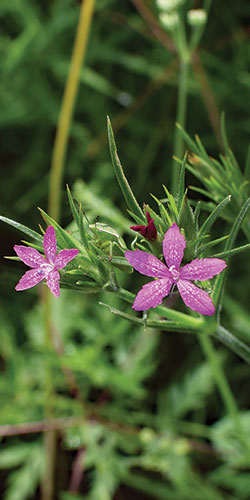
| Common name | Deptford pink |
| Scientific name | Dianthus armeria |
| Type of plant | Annual plant |
| Color flower | Pink / Red |
| Leaf color | Green |
| Flowering time | July / August |
| Location | Sun, partial shade |
| Evergreen | No |
| Height | 45cm |
The Deptford Pink, also known as Grass Pink, is a unique annual within the carnation family. Its scientific name is Dianthus Armeria. This carnation variety blooms from July to August, showcasing small pink or pink-red flowers. The plant typically reaches a height of around 45cm.
Unlike many other carnations, the Deptford Pink does not require full sun. It can thrive in the shade provided by a shrub or a tree.
The Deptford Pink is native to Europe and has become naturalized in North America.
Fringed pink
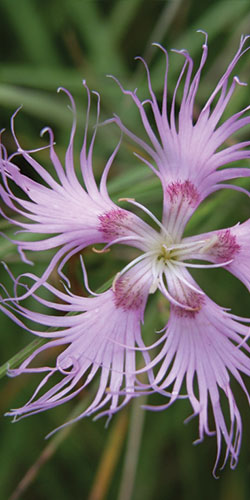
| Common name | Fringed pink |
| Scientific name | Dianthus superbus |
| Type of plant | Perennial |
| Color flower | Pink |
| Leaf color | Green |
| Flowering time | June / July |
| Location | Sun |
| Evergreen | Yes |
| Height | 60cm |
The fringed pink, scientifically known as Dianthus superbus, is a stunning perennial plant. It blooms with beautiful pink flowers from June to July and can reach a height of approximately 60cm.
This evergreen fringed pink is particularly suitable for south-facing gardens, thriving in sunny and warm locations. It fits perfectly within borders and effortlessly complements other plants.
During winter, it’s important to protect the fringed pink from excessive rain or snow. Conversely, in the summer, ensure that it doesn’t become too dry. Dianthus superbus remains visually appealing for several years, but it’s essential to sow new seeds or replace the plants in a timely manner to avoid unsightly gaps in your garden.
Maiden pink
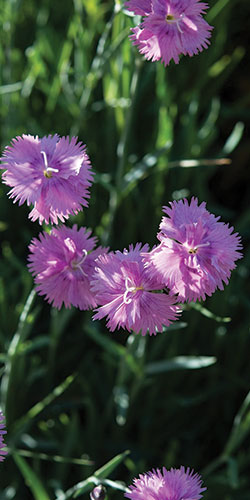
| Common name | Maiden pink |
| Scientific name | Dianthus deltoides |
| Type of plant | Perennial |
| Color flower | Pink |
| Leaf color | Green |
| Flowering time | June / July |
| Location | Sun |
| Evergreen | Yes |
| Height | 20cm |
The maiden pink, scientifically referred to as Dianthus deltoides, is a delightful plant. It produces lovely pink flowers and blooms from June to July. This particular variety of Dianthus typically reaches a height of around 20 centimeters, making it an ideal choice for rock gardens.
For optimal growth, plant the maiden pink in a sunny location with moderately nutrient-rich soil. It is a low-maintenance plant that works well as a ground cover, making it perfect for borders.
Carthusian pink
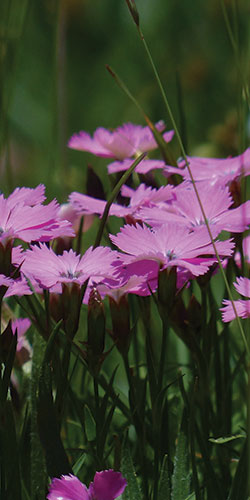
| Common name | Carthusian pink |
| Scientific name | Dianthus carthusianorum |
| Type of plant | Perennial |
| Color flower | Pink, Red |
| Leaf color | Green |
| Flowering time | June / July |
| Location | Sun |
| Evergreen | Yes |
| Heigth | 70cm |
The Carthusian pink, scientifically known as Dianthus carthusianorum, is a captivating perennial plant. It blooms with carmine-red flowers from approximately June to July and can grow up to a height of around 70cm.
For optimal growth, place the Carthusian pink in a sunny and warm spot within your garden. It thrives best in these conditions. This carnation flower is an excellent choice for borders as it blends harmoniously with other plants.
During winter, it is advisable to protect the Dianthus carthusianorum from excessive rain or snow. In the summer, ensure that it receives adequate watering to prevent dryness. Apart from these considerations, the Carthusian pink requires little additional care. It is almost non-invasive, making it a practical and convenient choice for your garden.
Carnation or clove pink
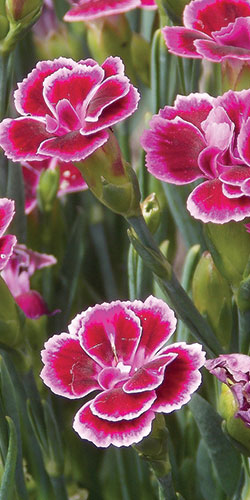
| Common name | Clove pink |
| Scientific name | Dianthus caryophyllus |
| Type of plant | Perennial |
| Color flower | Mixed |
| Leaf color | Grey |
| Flowering time | May / June |
| Location | Sun |
| Evergreen | Yes |
| Height | 25cm |
The common carnation, also known as clove pink, bears the botanical name Dianthus caryophyllus. Its flowers come in mixed colors and bloom during the months of May and June. This variety can grow up to approximately 25 cm in height. By lightly pruning the plant after its initial flowering, you may encourage a second blooming.
Dianthus caryophyllus is a ground cover plant that thrives in sunny locations.
Dianthus pink kisses
Now, let’s turn our attention to the remarkable carnation cultivar called ‘Pink Kisses.’ This particular variety is suitable for both gardens and indoor settings and has even garnered awards for its beauty. Dianthus Pink Kisses showcases abundant, two-toned flowers and features blue-green leaves. The initial bloom occurs between March and June, with the potential to flower until October.
Dianthus Pink Kisses is reasonably hardy and prefers a sunny spot with soil that ranges from dry to moderately moist. Providing it with plant food once a month will ensure a prolonged display of this stunning plant.
Rainbow pink
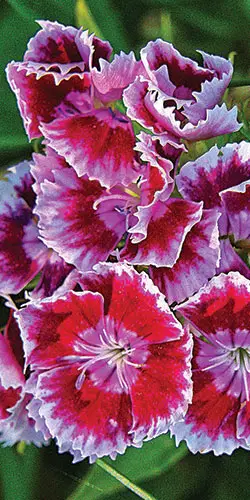
| Common name | Rainbow pink or China pink |
| Scientific name | Dianthus chinensis |
| Type of plant | annual-biennial plant |
| Color flower | Pink, Red |
| Leaf color | Green |
| Flowering time | June / July |
| Location | Sun |
| Evergreen | No |
| Height | 35cm |
The Rainbow pink, also known as China pink, is scientifically referred to as Dianthus chinensis. This beautiful variety displays pink to red flowers and blooms from June to July. It is a biennial plant that typically grows to a height of about 35cm.
Dianthus chinensis thrives in a sunny position, so choose a warm and sunny spot for optimal growth. It is important to keep the soil adequately moist, as this carnation variety is not well-suited to drought conditions. You can also plant it in pots and planters for added versatility and enjoyment.
Alpine pink
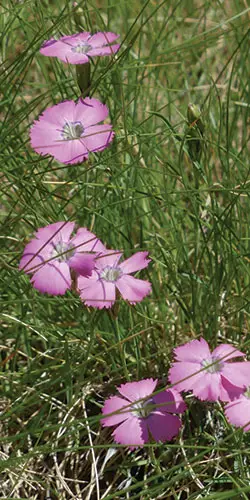
| Common name | Alpine pink |
| Scientific name | Dianthus alpinus |
| Type of plant | Perennial |
| Color flower | Pink, red |
| Leaf color | Green |
| Flowering time | June / July |
| Location | Sun |
| Evergreen | Yes |
| Height | 10cm |
The Alpine pink, scientifically known as Dianthus alpinus, is a captivating perennial plant. It produces beautiful pink-red flowers that bloom from June to July. This particular variety of carnation typically grows to a height of about 10 centimeters, making it an excellent choice for border plantings.
Dianthus alpinus is a hardy plant that maintains its vibrant green foliage even during winter. However, it is important to ensure that the soil remains dry in winter. Wet roots, combined with freezing temperatures, can cause damage to the roots and the plant itself.
The Alpine pink thrives in sunny locations with calcareous soil. During spring and autumn, it is advisable to keep the soil slightly moist.
Dianthus alpinus works well as a ground cover and complements other plants beautifully in garden landscapes.
Garden pink
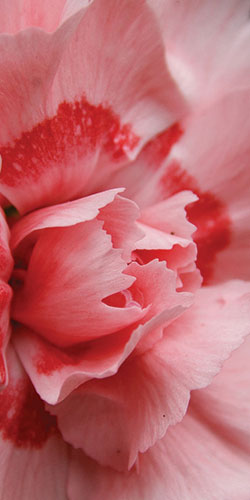
| Common name | Garden pink |
| Scientific name | Dianthus plumarius |
| Type of plant | Perennial |
| Flower color | Pink, purple, white |
| Leaf color | Blue-green |
| Flowering time | May untill August |
| Location | Sun, partial shade |
| Evergreen | Yes |
| Height | 30cm |
The garden pink, scientifically referred to as Dianthus plumarius, is a fast-growing and evergreen carnation flower. It displays stunning fringed flowers in shades of pink, white, and purple. Similar to other carnations, Dianthus plumarius thrives in sunny positions and is an excellent addition to your border.
This variety of carnation serves as a ground cover, featuring blade-like blue-green leaves. While it is generally hardy, it’s important to monitor its condition during wet winters. The roots of the garden pink are sensitive to excessive moisture and may not tolerate prolonged periods of wet soil well.
Kahori Pink
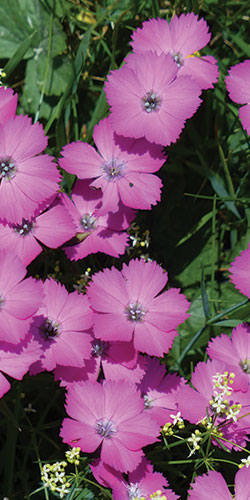
| Common name | Kahori Pink |
| Scientific name | Dianthus kahori |
| Type of plant | Perennial |
| Color flower | Pink |
| Leaf color | Blue-green |
| Flowering time | May untill October |
| Location | Sun |
| Evergreen | Yes |
| Height | 40cm |
The Kahori Pink is renowned for its delightful fragrance emanating from its flowers. Scientifically known as Dianthus kahori, this variety boasts stunning deep pink blooms. By pruning the Kahori Pink at the start of July, you can even enjoy a second round of blossoms in September and October.
To ensure optimal growth, provide the Kahori Pink with full sun exposure. It is a hardy plant but requires adequate watering to prevent dryness during the summer. However, in winter, it is crucial to avoid excessive soil moisture, as it can be detrimental to the plant’s health.
By maintaining these optimal conditions, you can cherish the beautiful blooms and captivating fragrance of the Kahori Pink.
Cheddar pink
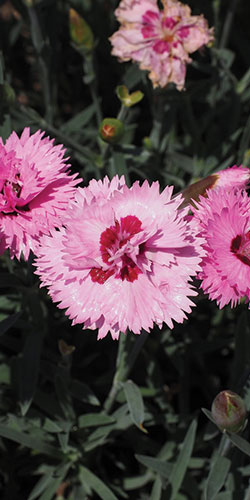
| Common name | Cheddar pink |
| Scientific name | Dianthus gratianopolitanus |
| Type of plant | Perennial |
| Color flower | Pink, Red |
| Leaf color | Grey |
| Flowering time | May / June |
| Location | Sun |
| Evergreen | Yes |
| Height | 25cm |
The Cheddar pink, scientifically known as Dianthus gratianopolitanus, is a delightful carnation flower that showcases beautiful pink-red blooms. This Dianthus gratianopolitanus variety flowers from about May to June and typically grows to a height of about 25 cm, retaining its green foliage all winter.
Dianthus care
Like other carnation flowers, Dianthus gratianopolitanus thrives in sunny locations and is an easy-care plant that produces vibrant and colorful flowers. To enjoy your Cheddar pink to the fullest, provide it with a slightly moist environment. This variety also exhibits good drought resistance, making it suitable for rock gardens or planting between stones and pavement. Combining the Cheddar pink with other plants will create a stunning display, thanks to its ground cover habit.
Caring for the Dianthus gratianopolitanus is relatively straightforward. During spring and autumn, it’s important to ensure that the soil remains slightly moist, as this promotes the development of the most beautiful carnation flowers. In winter, keeping the plant dry is crucial. By following these basic guidelines, you can fully appreciate the beauty of your carnation flowers.
The Cheddar pink is a hardy plant and can withstand frost without requiring extra care or protection against cold weather. However, it is crucial to choose the right soil type. Heavy soil, which retains excessive water during rainy or snowy periods, can be disastrous for your carnation flowers. Pay close attention to the soil conditions in your garden.
Dianthus plant
You can plant the Dianthus gratianopolitanus anywhere in the garden, but it prefers slightly moist and nutrient-rich soil. Find a sunny location with some partial shade for optimal growth. This variety demonstrates good tolerance to drought conditions, which is beneficial for the health of your carnation flowers.
When planting the Dianthus gratianopolitanus, it is advisable to supplement the soil with garden plant soil. This provides additional nourishment, especially during the initial vulnerable stage of the plants when they are not yet tolerant of drought. By considering these factors, you can create an ideal environment for your carnation flowers to flourish.

